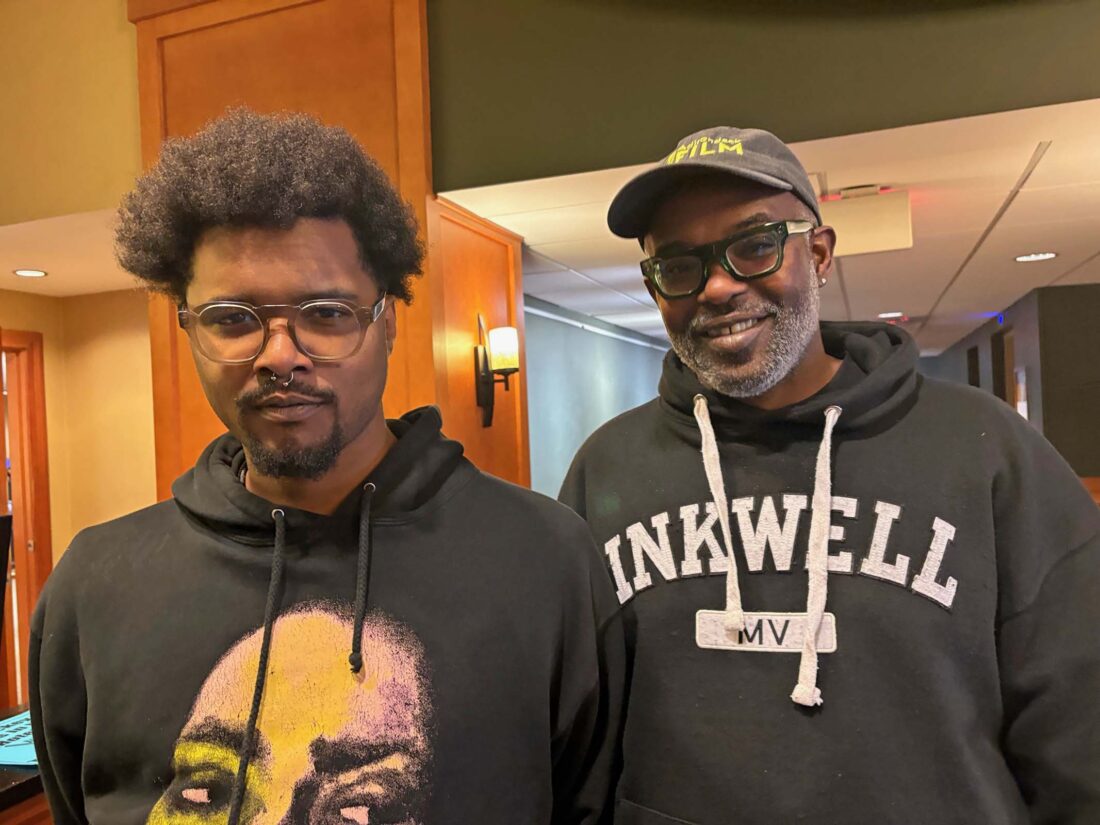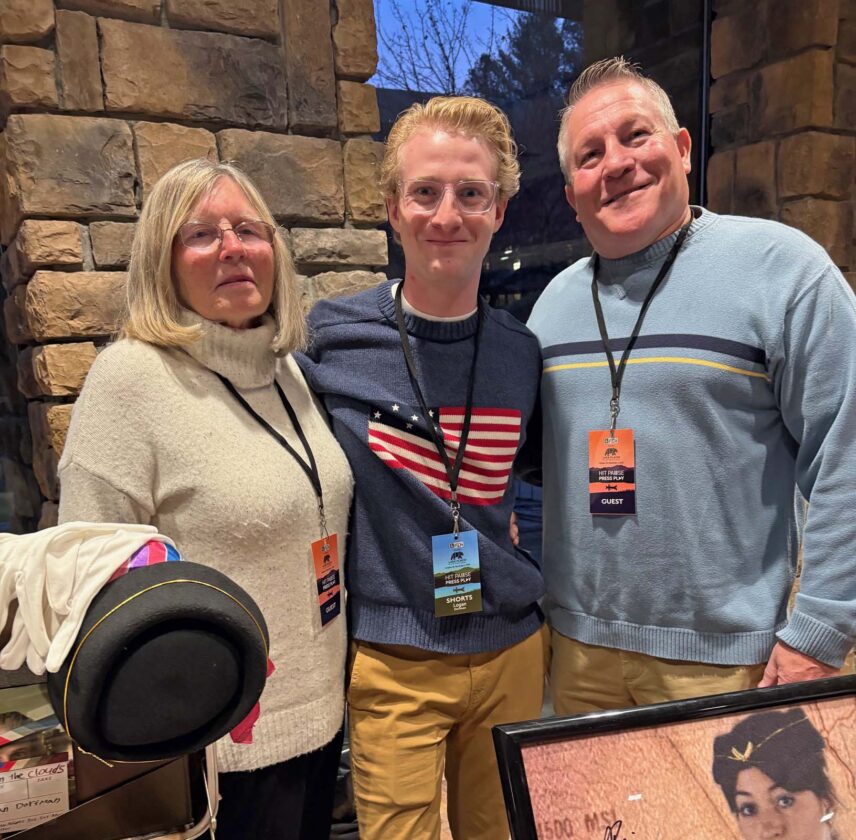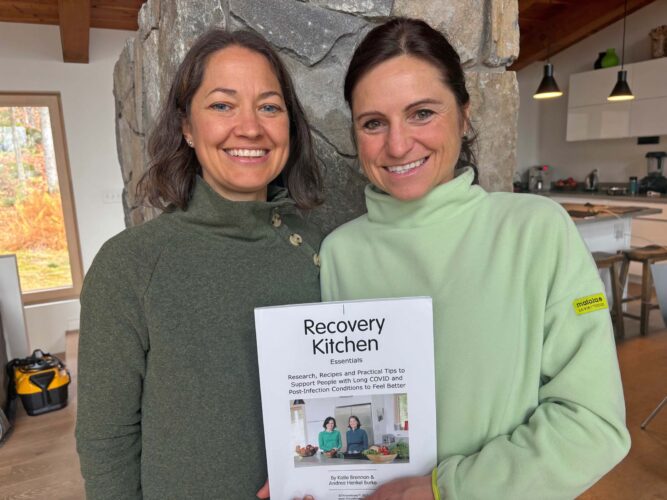ON THE SCENE: The Lake Placid Film Festival educates
- Colin Fickes, Gary Smith, Beth Davenport and Susie Sofranko at the Lake Placid Film Festival (Provided photo by Naj Wikoff)
- Filmmakers Chester Gordon and Elegance Bratton (Provided photo by Naj Wikoff)
- Logan Dorfman is seen with with his grandmother Bonnie Rizzuto and dad Chris Dorfman. (Provided photo by Naj Wikoff)

Colin Fickes, Gary Smith, Beth Davenport and Susie Sofranko at the Lake Placid Film Festival (Provided photo by Naj Wikoff)
Adirondack Film and the organizers of its lead event, the Lake Placid Film Festival, held Oct. 30 through Nov. 2, are working to increase the number of features, documentaries and specialty films produced in the Adirondacks.
Critical is developing a trained workforce capable of doing many of the jobs on the production side of filmmaking. Check the credits that roll at the end of a feature or documentary, and you’ll see a long list of job titles filled by the many people who work behind the scenes.
Another priority is providing a platform for often marginalized voices and at times challenging topics. This year, two standout films in that arena were “Move Ya Body: The Birth of House” and “Natchez,” the Mississippi city that was once home to the most millionaires and the second-largest slave market in America. The festival also showcased some upbeat films like “The Marching Band” and “Viva Verdi,” a documentary about Milan’s Casa Verdi, a retirement home for musicians established by Giuseppe Verdi in 1896.
Also, great fun were the three series of shorts by emerging and student filmmakers, and the informative and engaging seminars and panels focused on different aspects of filmmaking; both were important aspects of the Lake Placid Film Festival Student Summit, sponsored by Gary and Aimee Dake.
A delightful short was SUNY Oswego student Logan Dorfman’s film “Cipher in the Clouds,” a 10-minute senior thesis take on the search for D.B. Cooper, the plane hijacker who in 1971 parachuted out of a Northwest Orient plane with $200,000 in ransom money and has never been seen since. The film went on to win Best Student Film in the Your Shorts Are Showing category.

Filmmakers Chester Gordon and Elegance Bratton (Provided photo by Naj Wikoff)
“I didn’t know what I wanted to do at first, but when I saw the plane that D. B. Cooper jumped out of at the Rome Airport, that gave me the idea,” said Dorfman. “My story is about two detectives tracking him down. I had a lot of help from my friends, especially my dad, who was a pilot and could explain to me what happens on planes. I’m big on the twist at the end of a movie. I love that. My biggest challenge was getting the plane and filming the short in two days; I only had access to the plane for seven hours.”
An excellent experience for Logan and other student filmmakers was meeting producer Chester Gordon and director, writer, and producer Elegance Bratton, who directed “Move Ya Body: The Birth of House.” As a step back, house music is a compelling electronic dance music genre with a strong bassline, featuring disco, drum machines, synthesizers and vocals. House music, named after the Warehouse Club where it started, was created in Chicago in the 1980s following the Disco Demolition Night. This event turned into an anti-gay, black riot that took place in Comiskey Park in 1979.
Bratton and Gordon, who met in film school, shared their decade-long struggle to give voice to Black, gay, and queer people to illustrate the power of people’s shared humanity.
“Most people who have privilege and power don’t realize they have it most of the time in a way that those of us who feel oppressed are always aware of that oppression,” said Bratton.
As a consequence, in all aspects of their filmmaking, they sought to create opportunities to share the humanity of the marginalized, at times in ways that might make some viewers feel uncomfortable.

Logan Dorfman is seen with with his grandmother Bonnie Rizzuto and dad Chris Dorfman. (Provided photo by Naj Wikoff)
Together, they created the production company Freedom Principals. The duo shared clips from a range of shorts they made and, by featuring them at film festivals, finally gained acceptance and respect for their work and vision. This effort enabled them to create features, such as Bratton’s “The Inspection,” based on his brutal struggle as a queer Black man to go from homelessness to joining the Marines, where he learned to become a documentary filmmaker.
Their workshop, filled with over two dozen riveted student filmmakers, included the importance of watching films — lots of films — about three to four hundred “good, bad, whatever” a year, said Bratton. They emphasized the importance of sticking to your vision and being willing to walk away from an offer, no matter how tempting. They also urged the students to show their work in film festivals and to be willing to talk about it to audiences, no matter how small, as networking is crucial, and you never know who is in the room.
“Bratton and Gordon’s work, and this session, is incredibly inspiring, powerful, and meaningful,” said Sophia Monroe. “I cannot express how much it means that the film festival facilitated and invited these types of stories, the diversity and power behind them, so they could have a platform and share their voice. It’s beautiful to see how respected and valued these filmmakers are by the festival and the attendees.”
A panel moderated by Paul Hardart dove into the opportunities and benefits behind Adirondack Film partnering with Stockade Works to make the Adirondack region a viable destination for film production. On the panel were Beth Davenport, Colin Fickes and Susie Sofranko of Stockade Works, who have successfully increased film production in the mid-Hudson region.
“Forty percent tax credits are important,” said Hardart. “But they are only good if there are people in the region who can serve on a crew, who can do the work, which is why working with Stockade is so essential.”
Stockade Works, founded by actress, director, and producer Mary Stuart Masterson in 2016, trains, mentors and creates opportunities for people in the mid-Hudson seeking to enter film production. They do not plan to expand their program to the Adirondacks, but instead share their model with Adirondack Film and provide mentoring and training so they can develop a similar program.
“We are now fielding calls from film producers and directors two to three a week,” said Gary Smith, director of the Lake Placid Film Festival. “We were scouted for a major film, now playing. We didn’t get it because we didn’t have a film crew. We have come to understand that these electricians, carpenters, and other needed skills are transferable.”
In short, Smith is looking for people interested in learning how to enhance their skill sets and make our region attractive to filmmakers. Smith can be reached through the Adirondack Film Society.
“Showing at film festivals like Lake Placid is vital because you want everybody to see your film,” said filmmaker Bryant Carroll. “Lake Placid attracts a great film community. Because they selected our film, of course, we’re going to come up and support the film festival, and because, hopefully, it will lead to more opportunities in film.”
(Naj Wikoff lives in Keene Valley and has been writing his column for the Lake Placid News since 2005.)


